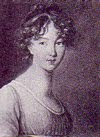
Mrs. Eunecia Street Stebbins (1759-1817), 1805-1806
Reuben Mouthrop (1763-1814), American
Oil on canvas under glass
30" x 24"
Owner: Howard S. Ranson, Connecticut
(according to the Art Inventories Catalog
Smithsonian American Art Musuem
Smithsonian Institution Research Information System)
I love portraits of the American colonial era and I particularly like this painting. I have a large photograph of it from a catalogue from Christie's (1998) which shows the beautiful green fabric of the gown, the black lace shawl, the fabulous cap and, of course, the stocking on the four exquisite thin needles. The sitter, as in many paintings that are called primitive or folk art has a misproportioned body in that the arms, in this case, are too large and low for the body, and are far forward in the image. The hands are very big and the skin is a dusky pinkish-white with grey shadows all over. The face, though, is kindly and sweet, with more expression than is usually found in this genre. Mrs. Stebbins looks out directly at us, a hint of a slightly lop-sided smile about to break out, and no suggestion of annoyance in being disturbed at her knitting. On the contrary, she looks pleased to see us unlike other painted knitters who have graced this blog.
The knitting is of great interest and right there in the foreground, nice and clear. Four medium-length thin needles with a stocking begun in a very fine yarn - wool, silk, linen? There are no slubs in this yarn but, since it is in a painting, this means nothing. One can, however, almost count the stitches, 48 and about 10 more or so on the nearest needle, and 28 and a few more on the back needle. There are some, though not too many, on the needle closest to the body and none, as far as I can see, on the remaining needle, as if Mrs. Stebbins was just about to start working with that empty needle. Even though this is a painting, and so the accuracy cannot be trusted, the stitch count is not far off from a stocking I am currently knitting from The Knitting Teacher's Assistant, dated 1817, which is held to be the earliest collection of printed *patterns* currently available, at least in English. Mrs. Stebbins is knitting with very thin needles and fine yarn whereas the pattern suggests "coarse worsted and large needles" so I am using 3.25mm/3US needles and Harrisville Designs 2 ply Shetland wool in Marigold. I adore the texture and colour of this wool so I am whipping up these stockings fairly quickly and will discuss them in another post very soon.








